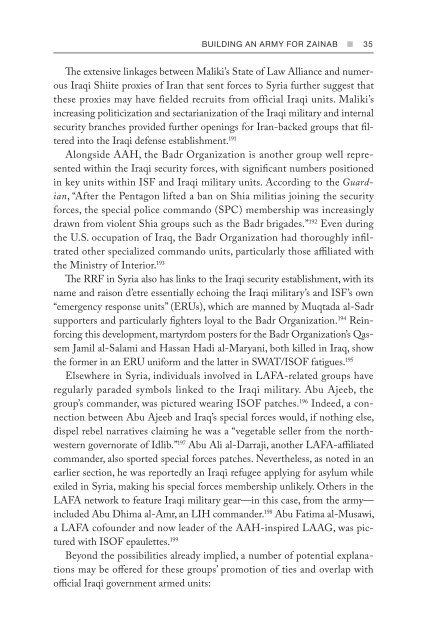Create successful ePaper yourself
Turn your PDF publications into a flip-book with our unique Google optimized e-Paper software.
BUILD<strong>IN</strong>G AN ARMY FOR ZA<strong>IN</strong>AB n 35<br />
The extensive linkages between Maliki’s State of Law Alliance and numerous<br />
Iraqi Shiite proxies of Iran that sent forces to Syria further suggest that<br />
these proxies may have fielded recruits from official Iraqi units. Maliki’s<br />
increasing politicization and sectarianization of the Iraqi military and internal<br />
security branches provided further openings for Iran-backed groups that filtered<br />
into the Iraqi defense establishment. 191<br />
Alongside AAH, the Badr Organization is another group well represented<br />
within the Iraqi security forces, with significant numbers positioned<br />
in key units within ISF and Iraqi military units. According to the Guardian,<br />
“After the Pentagon lifted a ban on Shia militias joining the security<br />
forces, the special police commando (SPC) membership was increasingly<br />
drawn from violent Shia groups such as the Badr brigades.” 192 Even during<br />
the U.S. occupation of Iraq, the Badr Organization had thoroughly infiltrated<br />
other specialized commando units, particularly those affiliated with<br />
the Ministry of Interior. 193<br />
The RRF in Syria also has links to the Iraqi security establishment, with its<br />
name and raison d’etre essentially echoing the Iraqi military’s and ISF’s own<br />
“emergency response units” (ERUs), which are manned by Muqtada al-Sadr<br />
supporters and particularly fighters loyal to the Badr Organization. 194 Reinforcing<br />
this development, martyrdom posters for the Badr Organization’s Qassem<br />
Jamil al-Salami and Hassan Hadi al-Maryani, both killed in Iraq, show<br />
the former in an ERU uniform and the latter in SWAT/ISOF fatigues. 195<br />
Elsewhere in Syria, individuals involved in LAFA-related groups have<br />
regularly paraded symbols linked to the Iraqi military. Abu Ajeeb, the<br />
group’s commander, was pictured wearing ISOF patches. 196 Indeed, a connection<br />
between Abu Ajeeb and Iraq’s special forces would, if nothing else,<br />
dispel rebel narratives claiming he was a “vegetable seller from the northwestern<br />
governorate of Idlib.” 197 Abu Ali al-Darraji, another LAFA-affiliated<br />
commander, also sported special forces patches. Nevertheless, as noted in an<br />
earlier section, he was reportedly an Iraqi refugee applying for asylum while<br />
exiled in Syria, making his special forces membership unlikely. Others in the<br />
LAFA network to feature Iraqi military gear—in this case, from the army—<br />
included Abu Dhima al-Amr, an LIH commander. 198 Abu Fatima al-Musawi,<br />
a LAFA cofounder and now leader of the AAH-inspired LAAG, was pictured<br />
with ISOF epaulettes. 199<br />
Beyond the possibilities already implied, a number of potential explanations<br />
may be offered for these groups’ promotion of ties and overlap with<br />
official Iraqi government armed units:


